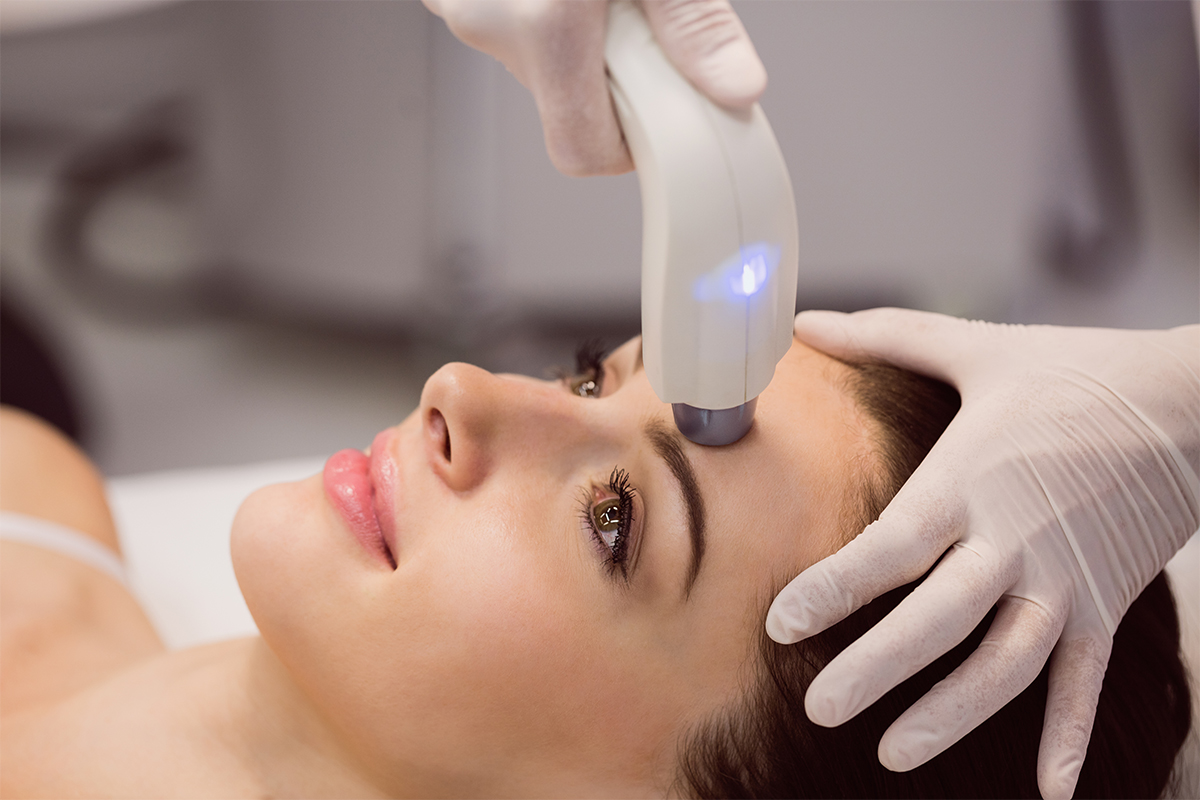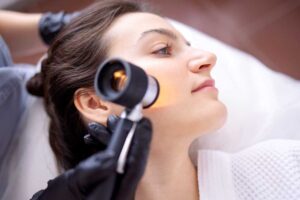IPL (Intense Pulsed Light) therapy is like a multitasker for your skin. It’s mostly used to fade sunspots and even out blotchy skin tone—basically, all the stuff that creeps in with age or too much time in the sun. IPL can also help with broken capillaries, rosacea, and acne. Over time, things start to look more transparent and more balanced. It’s not a magic wand, but with a few IPL sessions, you’ll probably notice your skin looking more refreshed. So, if you are looking for a complete guide on how IPL treatment works, you are in for a treat!
What is IPL (Intense Pulsed Light)?
IPL therapy is a safe and practical solution for treating skin pigment conditions and vein changes. It uses light energy to target specific pigment cells and blood vessels without harming other tissues, activating the healing response of your body.
As part of your treatment, protective eyewear will be provided for exposure to bright light pulses. A practitioner presses a device against your skin and emits short bursts of filtered light targeted toward specific areas that concern you. The treatment may also include internal cooling systems to soothe any discomfort.
For unwanted hair removal, IPL pulses of light target melanin within hair follicles to cause it to break down and enter its resting phase. It works best on dark hair, so make sure that you shave or epilate before treatment.
How IPL Differs from Laser Treatments
IPL devices use various wavelengths of pulsating light energy to target pigmented skin cells and hair follicles with pulses of light energy, similar to laser treatments but without targeting all layers of skin at once, thus minimizing complications or irritation risk. Here are some major differences between IPL and laser treatment:
Intense Pulsed Light Source
IPL uses a broad spectrum of light, so it covers a wider area and is great for things like sun spots, dark spots, redness, and general skin tone issues. Lasers, on the other hand, use a single focused wavelength, which makes them better for precise treatments like tackling deep wrinkles or removing tattoos.
Skin Types
Lasers can be adjusted to suit different skin tones and types, making them safer for a wider range of individuals. IPL, on the other hand, may not be suitable for darker skin tones due to the risk of burns or pigmentation changes.
If you want to learn more about the differences, read our blog on Microneedling vs IPL Treatment. You’ll get the idea for what you have to choose.
What is the Process of IPL Treatment?
At an IPL treatment session, a medical professional will use a handheld device to flash light pulses onto specific areas of your face or body. Pulses absorbed by melanin in hair follicles stop growth quickly compared with laser treatments, but for maximum hair reduction, multiple sessions are required.
IPL therapy can also effectively target vascular lesions, including small blood vessels (angiomas and telangiectasia). Pulsed light energy is absorbed into these lesions’ vessels and converted to heat; damaged vessels clear quickly before reabsorbing back into your body. You’ll likely notice improvement after just one or two treatment sessions!
How IPL Targets Pigmentation?
Brown spots, age spots, and freckles result from excess melanin production in the epidermis. IPL treatment heats up and destroys this melanin to fade any discoloration in treated spots; they may darken slightly upon treatment but will ultimately fade painlessly over time for brighter and healthier skin.
An IPL session involves applying pulses of light directly onto your skin surface to cause thermal injury to the pigment cells responsible for discoloration or other irregularities. This prompts your body’s natural healing response and eventually leads to their removal by natural means as your skin heals itself and reveals new, healthy tissue underneath.
Benefits of IPL Treatment
Here are some benefits of IPL Treatment:
Minimal Discomfort
IPL treatment is generally safe for most individuals; however, pregnant women or those taking certain medications should consult their aestheticians to determine whether this form of therapy will be appropriate for them.
No Downtime For Recovery
Laser hair removal treatments often require several days or weeks of recovery time before you can resume regular activities; with IPL treatment, no such downtime is required. The cooling gel may be applied during treatment sessions, which typically last 20-30 minutes and involve snapping sensations similar to what some patients describe as the feeling of rubber bands against the skin.
Minimal Side Effects
Like every other treatment, you may notice some side effects, but they are not long-lasting. In the field of clinical and aesthetic dermatology, IPL treatments have been shown to effectively manage hair growth and other skin conditions:
- Redness and Swelling
- Mild Discomfort
- Sunburn-like Sensation
- Temporary Pigmentation Changes
To minimize any further irritation after your procedure and ensure optimal healing results, follow post-treatment guidelines by applying aloe vera. Or sunscreen with SPF 30+ (especially in sun exposure) each day after your photofacial session to promote healing and reduce unwanted side effects.
Common Skin Concerns Treated by IPL
Intense Pulsed Light technology can effectively address many skin concerns, from age spots and redness to sun damage, broken capillaries, and uneven tone. Common issues addressed by IPL include age spot removal, redness reduction, and sun damage repair.
IPL may also reduce broken capillaries, rosacea symptoms, or uneven complexion tone. As is common following treatment sessions, the skin may appear slightly red or pink afterward—this is entirely normal and typically fades within a day or two. Furthermore, individuals will feel an unpleasant stinging sensation similar to having a mild sunburn.
Is IPL Safe for All Skin Types?
IPL is most effective for individuals with Fitzpatrick skin types I to III—those with fair to light brown skin tones. These skin types have lower melanin levels, allowing the IPL light to target pigmentation and vascular concerns without affecting the surrounding skin.
For individuals with Fitzpatrick skin types IV to VI—darker skin tones—IPL treatments carry a higher risk of side effects such as hyperpigmentation or scarring. The increased melanin in these skin types can absorb more light energy, potentially leading to adverse reactions.
Bottom Line: IPL is a Safe Treatment
IPL is an effective, non-invasive treatment for various skin concerns. Here’s what you know after reading our guide:
- IPL uses light pulses to target pigmentation, redness, and skin texture.
- It works for sun spots, broken capillaries, rosacea, and more.
- Suitable for fair to light skin tones, with minimal side effects and no recovery time.
- Results improve with multiple sessions and regular maintenance.
After your IPL treatment session, it is vitally important that you follow your dermatologist’s post-treatment instructions. Use a high SPF sunscreen and limit direct sunlight as much as possible for maximum results.
Book your IPL treatment at Skin Artistry Clinic
At Skin Artistry Clinic, our IPL Photofacial treatments are designed to target the root of these concerns—gently and effectively. Whether you’re after a brighter complexion or smoother texture, our expert team will tailor the treatment to your skin’s unique needs. Don’t wait for flawless skin to happen—book your IPL session today and let your glow take center stage.



